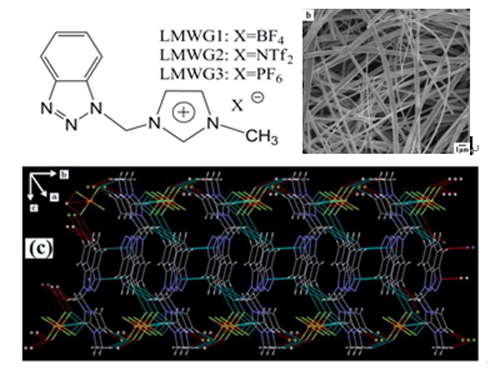Researchers from the State Key Laboratory of Solid Lubrication of the Lanzhou Institute of Chemical Physics have devised a novel low molecular weight gelator (LMWG) that is structurally an ‘‘ionic liquid’’ bearing a benzotriazole group.
The LWMG can gelate ILs via supramolecular assembly to form fibrous structures. The benzotriazole group endows anticorrosion and antioxidation properties of the gelator, which together with good conductivity give the obtained ionic gel great potential as noncorrosive solid electrolytes for solar cells, supercapacitors and batteries. These characters also make them potential high performance semi-solid lubricants, especially for some electrical contacts, that can be used at low temperatures and liquify upon mechanical shearing with low friction and good antiwear properties.
ILs possessing extremely low volatility, nonflammability, high thermal stability and conductance, have been widely investigated. Ionic gels formed with ILs possess high ionic conductivity and wide electrochemical window and are prospective solid electrolytes for lithium batteries, dye-sensitized solar cells, electromechanical actuators, capacitors etc. The gelators form entangled three-dimensional networks in which ILs are entrapped through weak intermolecular interactions such as H-bonding, p–p stacking, van der Waals force and electrostatic interaction. The gelators for ILs include polymeric materials, and inorganic substances, such as silica nanoparticles and carbon nanotubes. There have been only a few works on ionic gels formed by physical gelation of LMWGs.
The work has received support from the ‘‘Hundred Talents Program’’ of Chinese Academy of Sciences and the NSFC. The findings have been published in J. Mater. Chem. (J. Mater. Chem., 2011, 21, 13399).
J. Mater. Chem. Paper

Low molecular weight gelator, fibrous structures, wireframe molecular model of the supramolecular assembly (Image by ZHOU Feng et al.)










